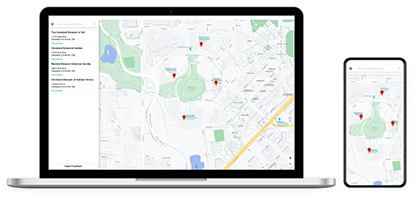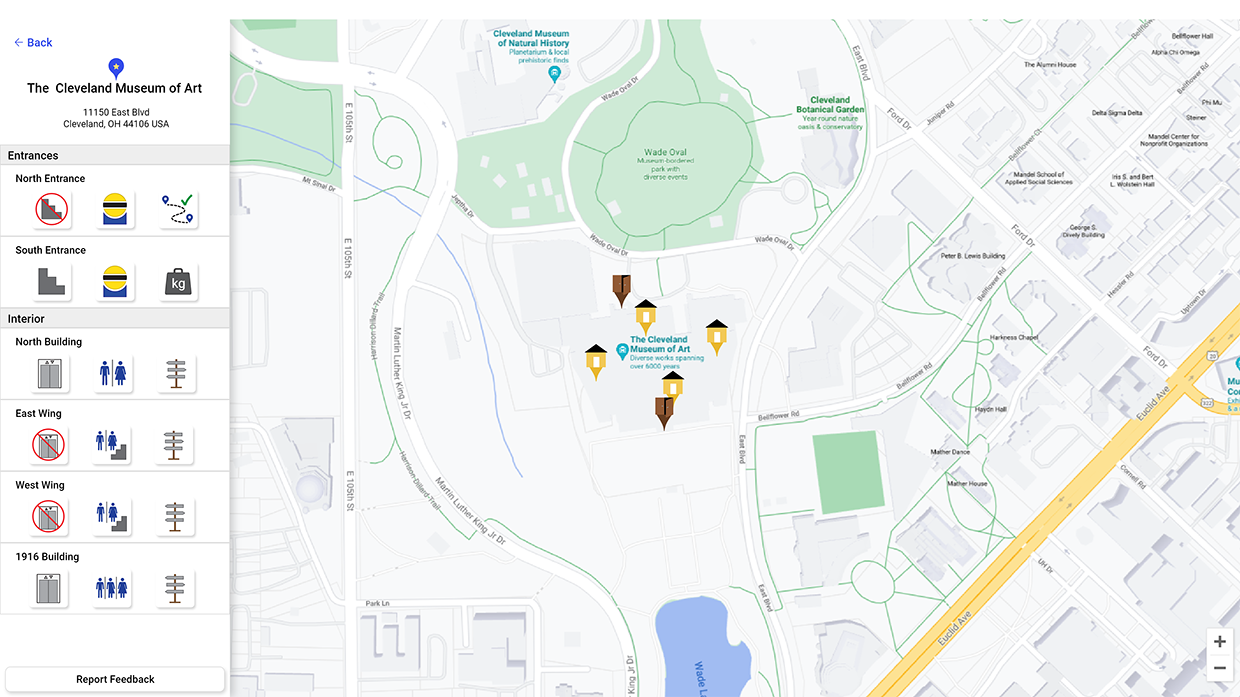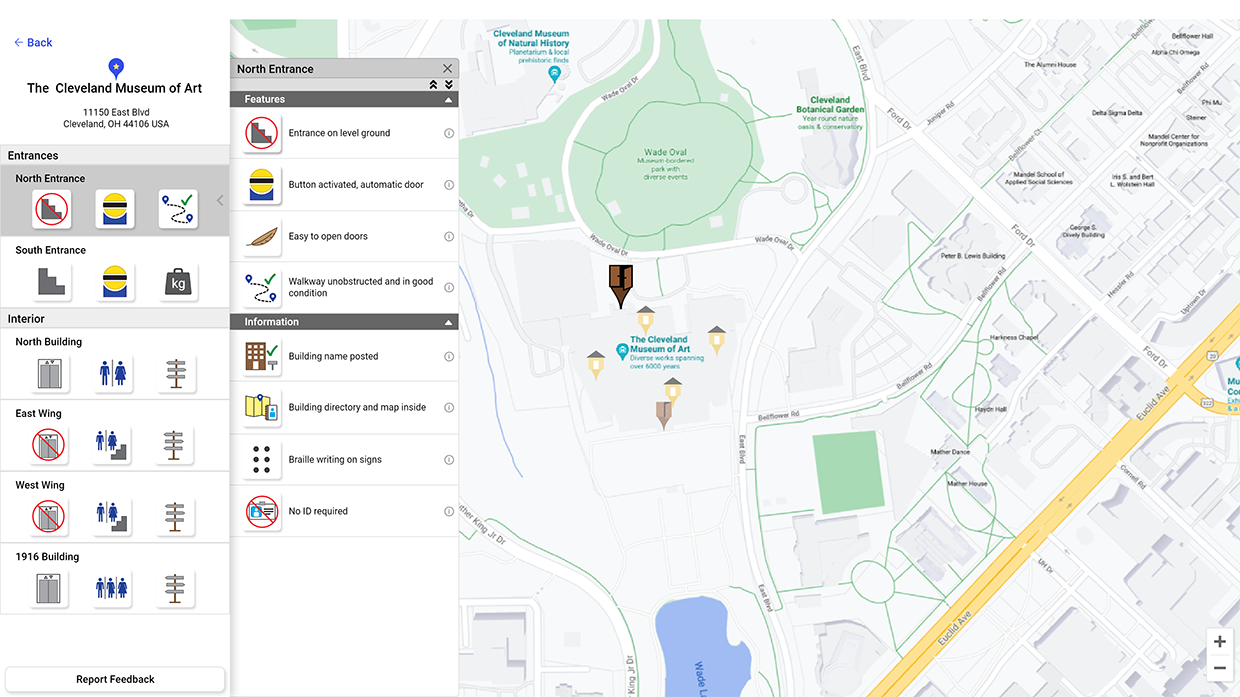Disability and Testing Services
Cleveland State University
Disability & Testing Services
2124 Chester Avenue
Rhodes Tower West (RW) 210
Cleveland, Ohio 44115
Phone: 216-687-2015
Fax: 216-687-2343
ods@csuohio.edu
Testing Services
2124 Chester Ave.
Rhodes Tower West (RW) 215
Cleveland, Ohio 44115
Phone: 216-687-2272
Fax: 216-687-2212
testingservices@csuohio.edu
Dr. Nick Petty
Director, Disability and Testing Services
Jeffery Dell
Asst. Director Assistive Tech
HAILEY CYRUS
Manager, Testing and Note Taking Services
Mary Lynn Dixon
Specialist, Disability and Testing Services
BILL MILHOAN
Specialist, Accessible Media
IRIS ZANA
Test Proctor
CSU Accessibility Mapping Project
Help make CSU's campus more inclusive and accessible!
Volunteer for one of our campus mapping events on Wednesday, April 6th from 12-5pm or Friday, April 8th from 12-5pm! Use this form to sign up!
Project Overview
For some campus-community members, overcoming barriers to accessibility is a constant struggle. To others, these same barriers are hardly given a second thought. The purpose of this project is to flip this paradigm by recruiting volunteers to help take an intentional look at the campus environment in order to identify and highlight any barriers community members might encounter.
For this project, the Office of Disability Services is partnering with a local company, Constellar User Design Solutions, to use the information about the campus that we collect to create a digital map of all the accessibility features within and around CSU's campus facilities. This map will be made available online, in both a desktop and mobile-friendly format, as a free resource for individuals, with or without disabilities, to use as a guide to better navigate CSU's campus. To give you an idea of what this map will look like, check out the images below, showing a demo map created for the Wade Oval museums.
Image Description: The accessibility map shown above is a web application, easily accessed on a laptop via a web browser, shown on the left, or on a mobile device via a web browser, shown on the right. Both the laptop and mobile displays show the main screen of a demo map created for the Wade Oval museums, with markers on the Cleveland Museum of Natural History, Cleveland Museum of Art, Cleveland Botanical Garden, and Western Reserve Historical Society. On the left side of the laptop display, there is a panel with a search bar at the top, followed by the 4 locations and their addresses, shown in a list below the search bar.
Image Description: Shown above is the details view of the accessibility map for the Cleveland Museum of Art. On the left side of the screen is a details panel, with the museum's name and address at the top. Below this is a list of two entrances: the North Entrance and South Entrance, followed by a list of four interiors: the North Building, the East Wing, the West Wing, and the 1916 Building. For each of these entrances and interiors there are three icons indicating highlighted information for each portion of the museum. To the right of this details panel is the map, centered on the art museum with additional markers for each of the entities listed on the details panel.
Image Description: Selecting the North Entrance, as in the above image, a second panel slides out from under the details panel with the North Entrance labeled at the top. On this panel there is a category heading of "Features" with a list of accessibility criteria underneath, including information about the presence of stairs, the presence of automatic doors, the weight of the door, and the condition of the walkway leading up to the building. Following this, there is a second category heading of "Information" with more accessibility criteria underneath, covering information about the presence of the building's name, the presence of a navigational directory, the presence of Braille signage, and the necessity of an id to access the space.
How can you help?
First, we want to hear from you about your thoughts and experiences with accessibility! We will be hosting a number of discussions about accessibility that we want community members to participate in. These discussions will cover questions including what is accessibility, who is affected by it, and how can it be improved. These discussions are meant to inform the community about accessibility, as well as shape the final product for this project through community input.
If you're interested in participating in an accessibility discussion, use this signup form to find details on when our next discussion will be held.
After these discussions, we next need your help collecting information about the campus's buildings. We will be hosting campus-mapping events in which we will have small groups of individuals go to each building on campus to collect a variety of specific information related to accessibility. For instance, we want to know are there stairs leading up to a building's entrance, are there navigational signs posted throughout the building, is there Braille writing accompanying all signage, is the building well lit, are there gender inclusive bathrooms throughout the building, and more. We want to collect as much information as possible in order to help as many people as possible, but we can only do so with your help!
We have two campus mapping events scheduled for Wednesday, April 6th, and Friday, April 8th. If you're interested in helping out, please sign up for a time slot using this link.
Other Accessibility Mapping Projects
To give a little background about this project, accessibility mapping in general is not a new concept. There have been a number of schools, such as Vanderbilt University, University of Pennsylvania, and Arizona State University, who have conducted similar accessibility mapping projects and currently have maps active online for their students to use.
Out of these three schools, the Mapping Access project at Vanderbilt was of particular inspiration for this project. A central pillar of their ongoing project is to radically shift the community's perception of the spaces they inhabit and question the effectiveness of mindless compliance to government accessibility standards. Their goal was not simply to collect information to be made available, but to spark discussion and ignite change.
This is a goal adopted by this project. Engage with us and help us ignite change!
Our Project
How is this project different? This project differs in the presentation of the information we collect. Beyond the hope of promoting change, this project offers an opportunity to create an incredibly useful tool for day-to-day use. However, the approach used in designing this tool is of vital importance in order to produce something that is useful, practical, and, above all, easy to use.
This is where we, Constellar User Design Solutions, shine. We are an accessibility focused, user experience design agency. We create digital products that put the user at the center of the design process in order to produce solutions that are better suited to the exact needs and consideration of the people who will use them. That means, for this project we will create a map that has been designed for and tested with both users with and without disabilities, allowing us to create an effective tool that is quick and easy to use, keyboard-friendly, screen-reader friendly, and intuitive.
If you want to learn more about our company check out our website at www.constellardesign.com!
Cleveland State University
Disability & Testing Services
2124 Chester Avenue
Rhodes Tower West (RW) 210
Cleveland, Ohio 44115
Phone: 216-687-2015
Fax: 216-687-2343
ods@csuohio.edu
Testing Services
2124 Chester Ave.
Rhodes Tower West (RW) 215
Cleveland, Ohio 44115
Phone: 216-687-2272
Fax: 216-687-2212
testingservices@csuohio.edu
Dr. Nick Petty
Director, Disability and Testing Services
Jeffery Dell
Asst. Director Assistive Tech
HAILEY CYRUS
Manager, Testing and Note Taking Services
Mary Lynn Dixon
Specialist, Disability and Testing Services
BILL MILHOAN
Specialist, Accessible Media
IRIS ZANA
Test Proctor


